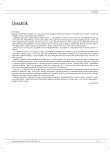The Effect of Repetitive Transcranial Magnetic Stimulation of the Cerebellum on the Upper Limb Performance in Early Parkinson’s Disease – Pilot Study
Authors:
E. Minks 1
; R. Mareček 1; T. Pavlík 3; K. Chroust 3; M. Bareš 1,2
Authors‘ workplace:
LF MU, Brno
1. neurologická klinika FN u sv. Anny v Brně
1; LF MU, Brno
Centrum pro abnormní pohyby a parkinsonismus 1. neurologické kliniky FN u sv. Anny v Brně
2; LF MU, Brno
Institut biostatistiky a analýz LF a PřF
3
Published in:
Cesk Slov Neurol N 2010; 73/106(1): 32-36
Category:
Original Paper
Overview
Objective:
The cerebellum is strongly involved in the motor system. Repetitive transcranial magnetic stimulation (rTMS) of the cerebellum influences the motor output of healthy volunteers. The aim of this study was to investigate whether rTMS of the cerebellum has the potential to affect motion of the upper limbs in Parkinson’s disease.
Materials and methods:
Ten patients in the early stages of Parkinson’s disease took part in the study. Every patient was given one session of rTMS with real stimulation and one session with sham stimulation. A three-month interval was left between sessions. Sequences were randomized and patients were blinded with regard to real/sham stimulation. A frequency of 1 Hz was employed, with a total of 600 pulses, with stimulation targeted on the lateral right cerebellum. Patients performed two motor tests with their fingers and hands both before and after rTMS procedures (9-hole peg test, ball test).
Results:
Results of the ball test revealed a significant improvement (p < 0.05) in performance of the right upper limb with real rTMS (patients required less time for this test after rTMS). A significant difference (p < 0.05) also emerged in this test with left upper limb and sham rTMS (also less time required to complete this test after rTMS). There were no significant difference in 9-hole peg test before and after (real or sham) rTMS and there was no difference in change of duration for motor tests between real and sham rTMS. No adverse event were recorded.
Outcome:
This pilot study did not demonstrate that cerebellar rTMS influenced the motor system of the upper limbs in a group of 10 patients with Parkinson’s disease. This study does, however, testify to the safety and performance of the method employed.
Key words:
repetitive transcranial magnetic stimulation – cerebellum – nucleus dentatus – Parkinson‘s disease
Sources
1. Husárová I, Bareš M. Účasť cerebella na kognitívnych a nemotorických funkcích v obraze funkčnej magnetickej rezonancie. Neurol pro praxi 2008; 9(4): 236–239.
2. Speer AM, Kimbrell TA, Wassermann EM, D Repella J, Willis MW, Herscovitch P, Post RM. Opposite effects of high and low frequency rTMS on regional brain activity in depressed patients. Biol Psychiatry 2000; 48(12): 1133–1141.
3. Koch G, Oliveri M, Torriero S, Salerno S, Gerfo E L,Caltagirone C. Repetitive TMS of cerebellum interferes with millisecond time processing. Exp Brain Res 2007; 179(2): 291–299.
4. Bareš M, Kaňovský P, Dufek J et al. Transkraniální magnetická stimulace. Brno: Národní centrum ošetřovatelství a nelékařských zdravotnických oborů v Brně 2003.
5. Bareš M. Nové trendy v transkraniální magnetické stimulaci. Neurol pro praxi 2008; 9(2): 79–82.
6. Kopeček M, Bareš M. Repetitivní transkraniální magnetická stimulace (rTMS) v léčbě deprese. Přehled publikovaných studií. Psychiatrie 2004; 8(2): 117–132.
7. Sedláčková S, Rektorová I. Repetitivní transkraniální magnetická stimulace a možnosti jejího potenciálního terapeutického využití u extrapyramidových onemocnění. Neurol pro praxi 2005; 6(5): 277–279.
8. Speer AM, Willis MW, Herscovitch P, Daube-Witherspoon M, Shelton JR, Benson BE et al. Intensity-dependent regional cerebral blood flow during 1-Hz repetitive transcranial magnetic stimulation (rTMS) in healthy volunteers studied with H215O positron emission tomography: I. Effects of primary motor cortex rTMS. Biol Psychiatry 2003; 54(8): 818–825.
9. Théoret H, Haque J, Pascual-Leone A. Increased variability of paced finger tapping accuracy following repetitive magnetic stimulation of the cerebellum in humans. Neurosci Lett 2001; 306(1–2): 29–32.
10. Miall RC, Christensen LO. The effect of rTMS over the cerebellum in normal human volunteers on peg-board movement performance. Neurosci Lett 2004; 371(2–3): 185–189.
11. Nagel M, Zangemeister WH. The effect of transcranial magnetic stimulation over the cerebellum on the synkinesis of coordinated eye and head movements. J Neurol Sci 2003; 213(1–2): 35–45.
12. Fierro B, Giglia G, Palermo A, Pecoraro C, Scalia S, Brighina F. Modulatory effects of 1 Hz rTMS over the cerebellum on motor cortex excitability. Exp Brain Res 2007; 176(3): 440–447.
13. Iwata NK, Hanajima R, Furubayashi T, Terao Y, Uesugi H, Shiio Y et al. Facilitatory effect on the motor cortex by electrical stimulation over the cerebellum in humans. Exp Brain Res 2004; 159(4): 418–424.
14. Koch G, Rossi S, Prosperetti C, Codecà C2, Monteleone F, Petrosini L et al. Improvement of hand dexterity following motor cortex rTMS in multiple sclerosis patients with cerebellar impairment. Mult Scler 2008; 14(7): 995–998.
15. Oxford Grice KO, Vogel KA, Le V, Mitchell A, Muniz S, Vollmer MA. Adult norms for a commercially available nine hole peg test for finger dexterity. Am J Occup Ther 2003; 57(5): 570–573.
Labels
Paediatric neurology Neurosurgery NeurologyArticle was published in
Czech and Slovak Neurology and Neurosurgery

2010 Issue 1
Most read in this issue
- Sco2 Protein Deficiency-Based Mitochondrial Encephalomyopathy with the SMA‑like Picture of Neurogenic Muscle Atrophy – Case Reports
- Olfactory Testing in Neurological Diseases using Odourized Markers Test
- Congenital Myasthenic Syndromes – Case Reports
- Evoked Responses and Electromyography in Intraoperative Monitoring in Neurosurgery
